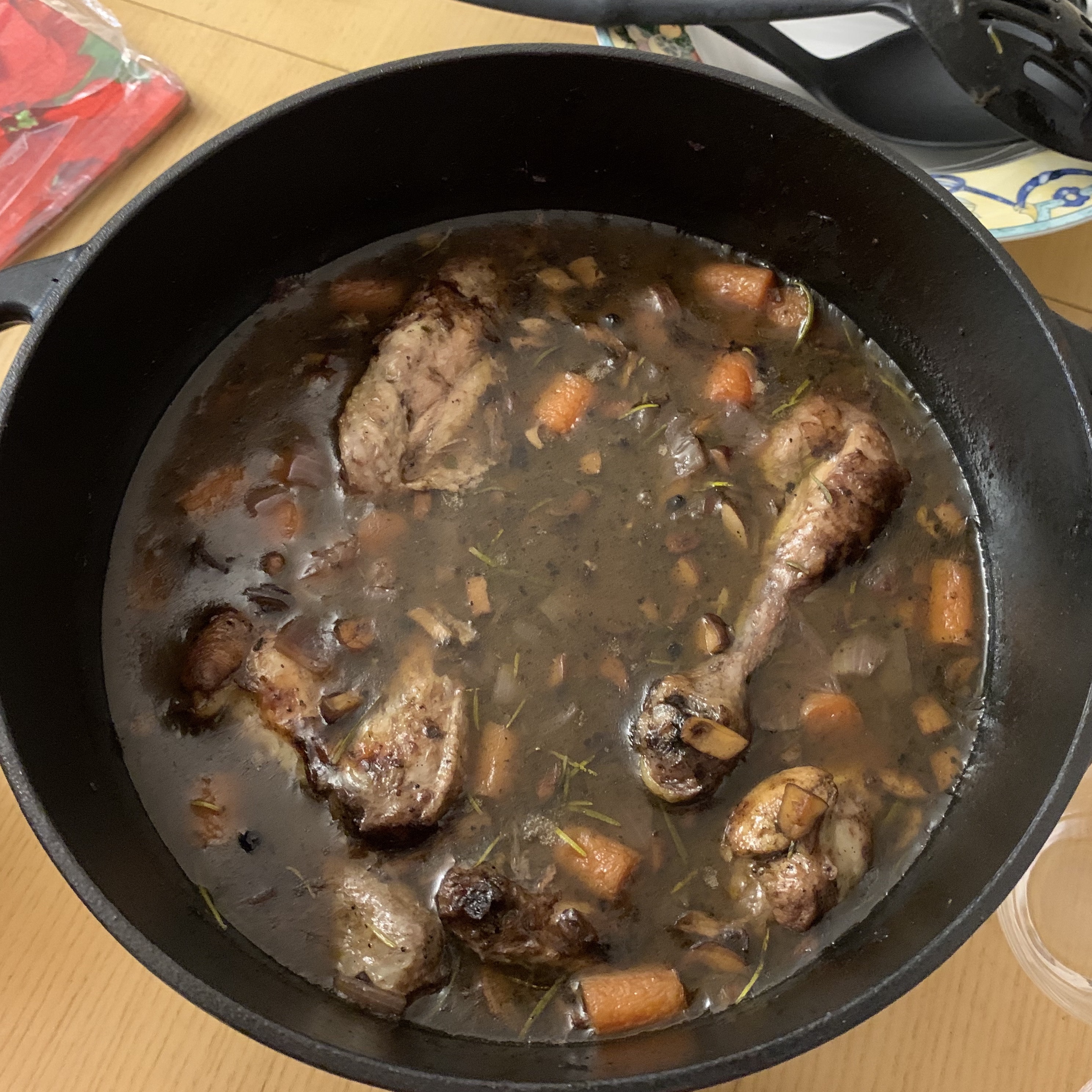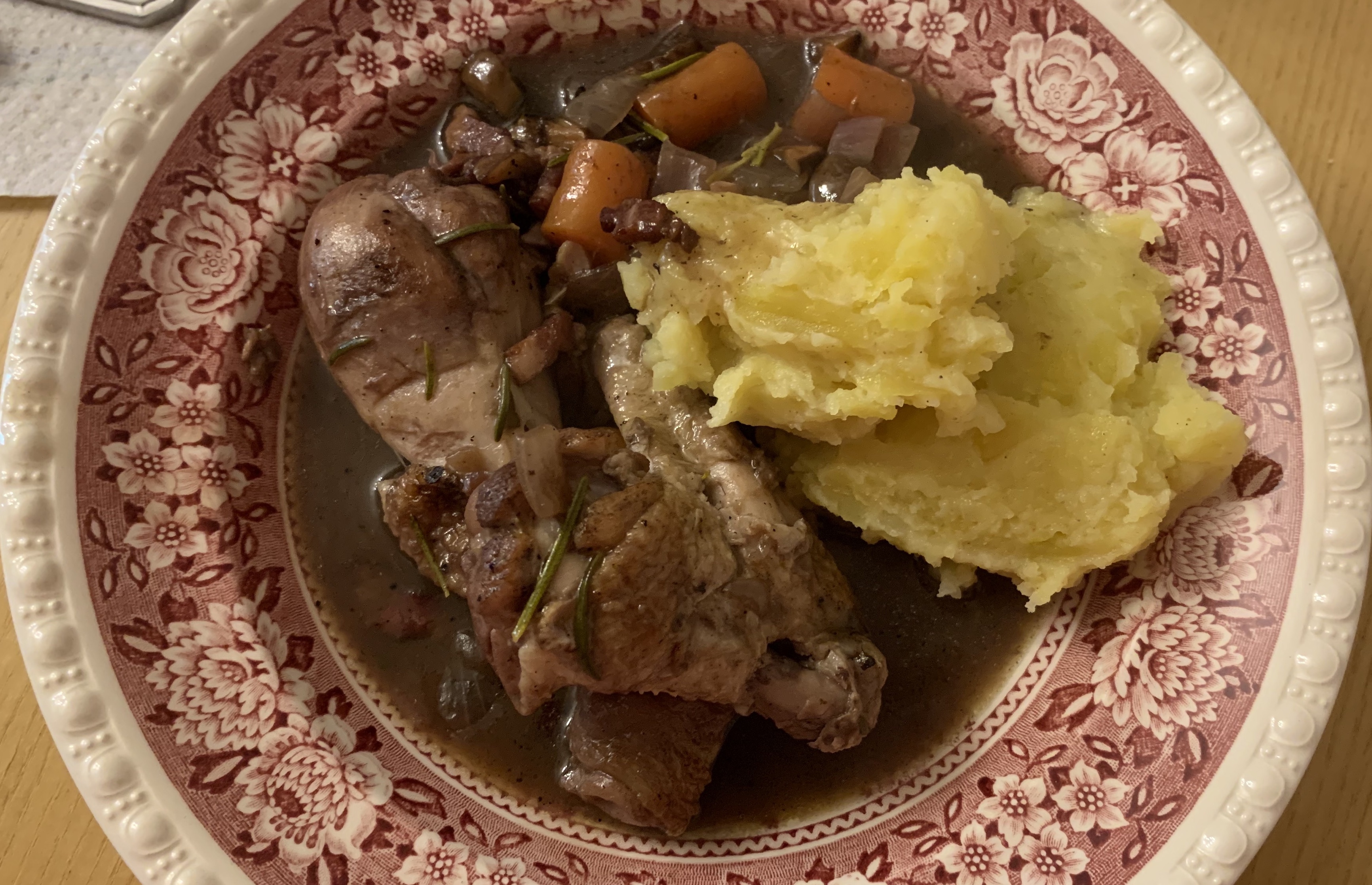Last weekend I tried out my hand at making some Coq au Vin - a French chicken stew that is as simple as it is delicious. It was the first time I’d tried making it, but it turned out so incredibly delicious that I just have to write about it so that y’all cooking along at home can try this out for yourselves.

Ingredients
To start off, you’re going to need some fresh, high-quality ingredients. Coq au Vin (literally Cock in Wine, although we’ll use chicken because you can’t really buy roosters) is peak French cuisine, very simple and low on extra flavourings, which means the difference between satisfying your soul’s apettite for the next month or so and comitting a criminal offense towards your taste buds is the quality of your ingredients.
The single most important component of the recipe is the wine. You’ll need some good red wine - I chose a 2019 dry Bordeaux, although you probably can’t go wrong with a Côte du Rhône. Stay away from the cheap generic Merlots, and for the love of all that is holy please do not get a wine that’s not French. You’ll want to tend towards the drier wines because it needs to drown out all the excess saltiness from the other ingredients. Oh and if you’re scared that good equals expensive in this category, fear not, at least in Europe. I paid about €6 for my bottle.
The other two high-quality ingredients you’ll need are a bottle of Cognac and the chicken itself. The Cognac is just for deglazing, but remember that the fond contributes a huge amount of flavour to the whole dish, so you can’t cheap out here. If you can, you’ll want to forego your Hennessey and other brand-name stuff and look at what boutique labels your supermarket has. This is where things potentially get expensive - my bottle cost in the €20 region, but for that I got a somewhat sweet Cognac delectably rich in complex aromas, and I’ve been looking for the tiniest excuse to get myself a small glass of that bottle ever since. And as for the chicken, get the freshest you can, with all the skin on. Skip the supermarket and go the butcher, and ideally get a whole bird or two, in the 700-900gm of meat per bird region.
The other things you’ll need are:
- Fresh bacon, the fattiest you can find. Depending on the fat content you’ll need anywhere between 200 - 400gm.
- Chicken stock, ideally self-made, but at this point I decided to use some boutique powdered stock that I’d gotten from Amazon some time ago.
- Whole black peppercorns.
- Finely chopped onions and baby carrots, and tiny pearl onions for garnishing.
- Champignons (mushrooms), medium sized with brown tops, roughly chopped with their stems removed.
- A few sprigs of fresh Rosemary and Thyme.
- Butter, ideally unsalted.
And once you have all of that on hand, you’re ready to begin cooking.
Recipe
Start by getting a cast iron stew pot on your stove or hot plate or whatever and melting all that bacon fat out. To extract the maximum amount of fat possible, add your bacon to a cold pot and remove the bacon once the pot gets ripping hot. Keep all that bacon aside; we’ll add it in later for garnishing.
Now in that ripping hot pot full of delicious bacon fat, sear your chicken pieces for about a minute and a half per side. Again, use your judgement - you want the skin browning, but not getting crispy, and definitely not burning. Once your chicken pieces are seared, again remove them and set them aside.
At this point, you’ve got a pot with a base of bacon fat and a lot of delicious, delicious sucs, or fond for you Americans. Add in your finely chopped onions, let it fry for about a minute and then deglaze with a dash of that Cognac. Add in the peppercorns, let the flavours get to know each other for a bit and then it’s time to build up the broth. Add in a third of the bottle of wine, then add in the carrots and the herbs. Stir on medium heat for about 15 seconds, and then add in the chicken pieces. Top it all off with the chicken stock, adding enough to just reach the top of the chicken pieces (I needed something close to 750ml for a kilo of chicken). At this point I also added in a few pinches of salt, but you probably don’t need to depending on how salty your stock and bacon was.
Now put the lid on and shove the whole thing into an oven pre-heated to 180 degrees C for about an hour. You don’t have too much time to rest however, because we have to prepare our garnishing. To a non-stick pan add a whole dollop of butter, and then fry all your mushroom pieces, until they lose all their moisture and then shrink and turn brown - this can take more time than my patience allows. Once they’re tiny and brown, turn off the heat and add the bacon bits back. And when the residual heat has gone away but not quite, add in the pearl onions so that just the outer layer fries and shrivels a bit before the pan loses all its heat.
Once the hour is up, take the pot out of the oven, and then add in your garnishing mix along with all the excess fat and butter drippings from the pan. Turn up the oven to 200 degrees now, add the pot back in without the lid, let it all cook for 10 minutes or so, and then take it out and serve hot with a side of mashed potatoes.

The mashed potatoes in the picture was made by a friend, which he described as how a traditional German housewife would make it. So to make your Kartoffelpüree, Brunhilde-Art, start by boiling de-skinned potatoes in water that’s as salty as you can get it, until you can stab a knife into it without using additional force. Take it out and start mashing, adding in powdered nutmeg, a bit of melted butter and (if you need it) some salt. While you’re mashing water will be lost in the form of steam, which you replace with full-fat milk, adding it teaspoon-by-teaspoon until you get to a consistency that you’re satisfied with.
And that’s all there is to it. Bon Appetit!